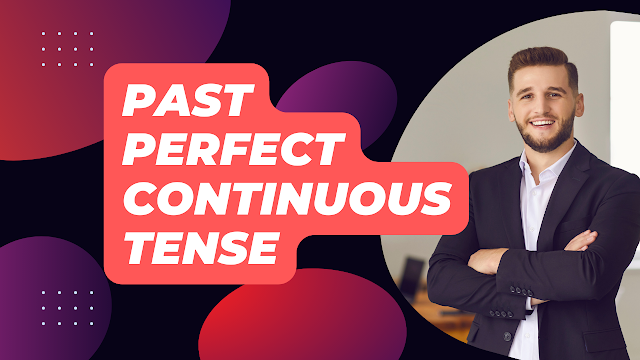Navigating the Past Perfect Continuous Tense: A Comprehensive Guide
 |
| Unraveling the Complexity of the Past Perfect Continuous Tense 🕰️📚 |
In the difficult canvas of English grammar, verb tenses are the threads that weave meaning into our sentences. One such complex thread is the "Past Perfect Continuous Tense." This tense allows us to express actions that were ongoing and had been continuing up to a specific point in the past.
In this comprehensive post, we will lighten up the Past Perfect Continuous Tense, exploring its structure, usage, and providing a multitude of examples and exercises to master this grammatical treasure.
Table of Contents
Demystifying the Past Perfect Continuous Tense
- A Quick Grammar Overview
- The Essence of Continuity
Deciphering the Structure
- Forming the Past Perfect Continuous Tense
- When to Use "Had Been"
- The Role of the Past Participle
Unveiling the Usage
- Expressing Duration in the Past
- Stating the Obvious
- Narrating Background Events
- Shedding Light on Past Progress
Past Perfect Continuous Tense Examples
- Sentence Structures
- Real-Life Scenarios
- Practice Exercises
Distinguishing Past Perfect and Past Perfect Continuous
- The Fine Line
- Clearing the Confusion
FAQs: Clarifying the Complexity
Conclusion: Embracing the Nuances of Grammar
Confusion of the Past Perfect Continuous Tense
A Quick Grammar Overview
Before understandng the specifics of the Past Perfect Continuous Tense, it's essential to understand the broader context of English verb tenses and where this tense fits into the timeline of actions.
The Essence of Continuity
The Past Perfect Continuous Tense is all about continuity. It enables us to communicate an action that had been ongoing and in progress up to a specific point in the past.
Encryption the Structure
Forming the Past Perfect Continuous Tense
The structure of this tense involves using "had been" followed by the base form of the verb and the "-ing" suffix. This structure conveys the idea that an action was ongoing in the past.
that is (S + had been + base form of verb with "ing" + O)
When to Use "Had Been"
Understanding when to employ "had been" is crucial. It typically appears in the past perfect continuous tense, distinguishing it from other past tenses.
The Role of the Present Participle
The present participle is a name given to base form of verb + "ing". It is an essential component in forming this tense. It adds depth and precision to the action's timing.
Unveiling the Usage
Expressing Duration in the Past
The Past Perfect Continuous Tense is the go-to choice when you want to communicate the duration of an action in the past. It strongly portrays the idea that something had been happening continuously in the past.
Stating the Obvious
In some cases, the Past Perfect Continuous Tense helps state the obvious. It emphasizes the ongoing nature of an action for added clarity.
Narrating Background Events
When narrating a story or background events in the past, this tense provides a rich context and conveys the sense of an action taking place while other events unfold.
Shedding Light on Past Progress
In specific contexts, such as explaining the progress or development of an action, this tense is the ideal choice.
Past Perfect Continuous Tense Examples
| Topic | Description |
|---|---|
| Sentence Structures | Explore various sentence structures that showcase the Past Perfect Continuous Tense in action. These examples will help you grasp how to construct sentences in this tense effectively. |
| Real-Life Scenarios | Dive into real-life scenarios where the Past Perfect Continuous Tense can be applied, from explaining work history to describing personal experiences. |
| Practice Exercises | Mastering this tense requires practice. Engage in exercises that challenge your understanding and ability to construct sentences in the Past Perfect Continuous Tense. |
Distinguishing Past Perfect and Past Perfect Continuous
The Fine Line
Clarify the subtle yet essential differences between the Past Perfect and Past Perfect Continuous Tenses. This section eliminates any lingering confusion between the two tenses. The Past Perfect tense indicates completed actions whereas the Past Perfect tense shows the long ongoing actions in the past time.
Clearing the Confusion
Examine common instances where learners tend to confuse these tenses. By understanding the distinctions, you can use them effectively in your writing and communication.
FAQs: Clarifying the Complexity
1. Can the Past Perfect Continuous Tense be used for short, quick actions in the past?
- No, this tense is specifically for actions that were ongoing and continuous. Short, quick actions are better expressed using other past tenses.
2. Is the Past Perfect Continuous Tense necessary, or can I use simpler tenses instead?
- While simpler past tenses can convey similar information, the Past Perfect Continuous Tense adds depth and detail to your narrative, particularly when emphasizing the duration of an action.
3. Are there certain time expressions that commonly accompany the Past Perfect Continuous Tense?
- Yes, phrases like "for," "since," and "how long" are frequently used to indicate the duration or continuity of an action.
4. Can the Past Perfect Continuous Tense be used in spoken conversation, or is it more common in writing?
- While it is less commonly used in casual spoken conversation, the Past Perfect Continuous Tense can add precision and nuance to written narratives.
5. Are there specific signal words to identify the Past Perfect Continuous Tense in a sentence?
- Words like "had been" and the "-ing" suffix on verbs are key indicators of this tense.
Conclusion: Embracing the Nuances of Grammar
- The Past Perfect Continuous Tense might seem complex, but its mastery opens doors to articulate, nuanced communication.
- Whether you're narrating past experiences, providing context in a story, or expressing the continuity of an action, this tense offers a powerful tool.
- By understanding its structure, usage, and distinctions from other tenses, you embark on a journey of precision and clarity in your language skills.
- Embrace the nuances of grammar and unlock a new level of expressiveness in your writing and communication.
REMEMBER THE KEY POINTS
PAST PERFECT CONTINUOUS TENSE
DEFINITION:
It is used to express a continued or ongoing action that started in past and continued until sometime in past. (Remember, an ongoing action in past which continued till some time in past) There will be a time reference, such as “since 1980, for three hours etc” from which the action had started.STRUCTURE: S + H.V. + 4th. F. V. + O (+ SINCE/FOR ...)
(HAD BEEN)USAGE OF "SINCE" : It is used before starting point or point of time. (i.e., morning, 2 o' clock etc)
USAGE OF "FOR" : It is used before calculated time or period of time.(i.e., two days, three weeks etc)
EXAMPLES:-
- I had been waiting for him for an hour. (A)
- I had not been waiting for him for an hour. (N)
- Had I been waiting for him for an hour? (I)
- She had been playing hockey since 7 O’clock. (A)
- She had not been playing hockey since 7 O’clock. (N)
- Had she been playing hockey since 7 O’clock? (I)
- You had been studying in this school for five years. (A)
- You had not been studying in this school for five years. (N)
- Had you been studying in this school for five years? (I)
So watch this video and tell me in the comment section what you think about it.






No comments:
Post a Comment